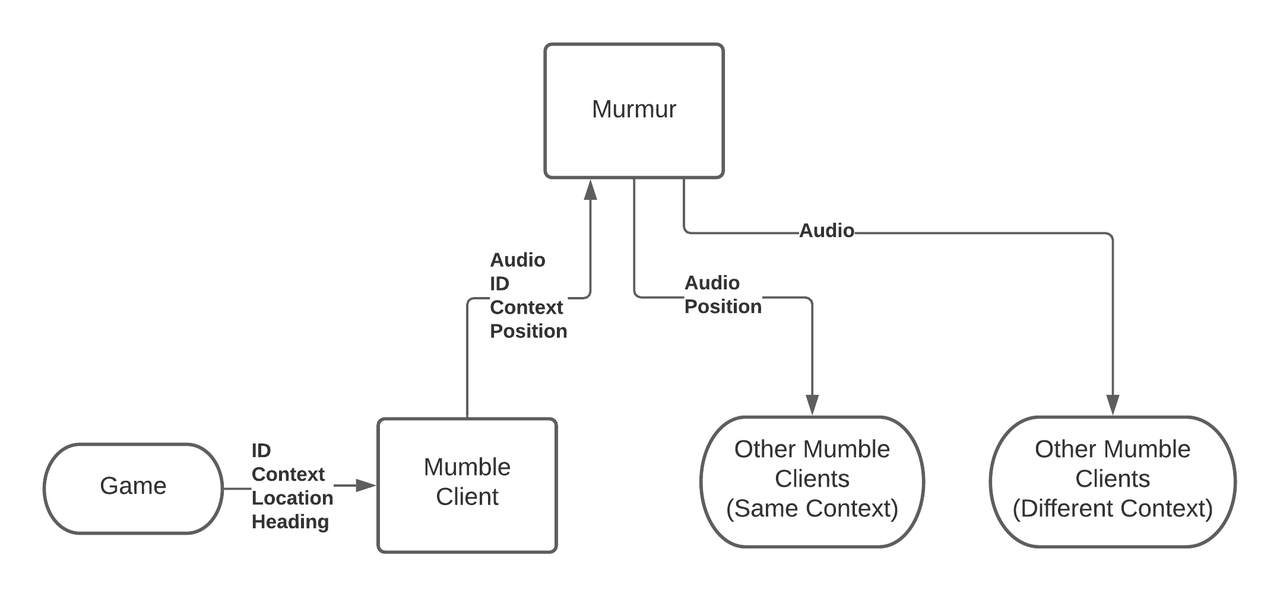Understanding Mumble Positional Audio
In my last post, I discussed some of the process of building a mod for Valheim that adds support for Mumble Positional Audio. During the process of helping some users troubleshoot, it became clear that it's not a terribly well understood system, and Mumble itself doesn't offer much feedback on what's actually going on. Where each bit of data is available and processed isn't obvious, and can lead to misconceptions about how things work.
System Overview
There are five main types of data at play in the positional audio system:
- ID: Unique identifier for each player. Might contain additional information (team, role, etc.)
- Context: Used to determine if two players should get positional audio from each other. Same context: Audio is positional. Different contexts: Audio is normal. This is always a two-way street. Either both players get positional audio, or neither does.
- Location: Your location in-game
- Heading: The direction you're facing
- Audio: Your voice picked up by your mic
Likewise, there are five types of actors in play:
- The Game: This provides data to the mumble client, either via built-in support for the Mumble Link protocol or via a Mumble plugin that snoops on its memory.
- The local Mumble client: The Mumble client running on the same computer as your game.
- Murmur: The mumble server. Gets input from each client and distributes it to the others.
- Other clients with the same Context
- Other clients with different Contexts
Not all of the data is available to all of the actors though, which can be surprising in some cases. The Game provides the ID, Context, Location, and Heading to the Mumble Client. Of these, the Heading is omitted from the data sent to Murmur. Why is that? Doesn't the server need to have all of the location and heading information from each client to change the audio to sound directional. It would, if that processing actually occurred on the server.
Instead, that processing is done completely client-side in Mumble. This makes a lot of sense. With N clients there are N2 - N streams to calculate the position of - for each client, there's one for every other client but itself. This would scale poorly and would require a much more powerful server.
Since the server doesn't calculate the position of the audio streams, each client needs to get the positional information for each audio stream. This is where the Context comes in. The ID and Context for each client is kept on the server and is not sent to the other clients. The server uses the Context to decide which clients need to receive positional information along with the audio streams from other clients. From your local Mumble's perspective, the audio stream from every user with the same Context will contain positional information. The audio streams from users with a different context will have no position attached.

Implications
- The only thing that's different between positional audio streams is the inclusion of a location in each audio packet.
- Every client always receives all of the audio.
- The decision around what can and can't be heard is made in the Mumble client based solely on the relative position of the stream.
- The audio and position data sent to each client with the same Context is identical. Either positional audio works for everyone in the group, or it works for no one. Any differences in user experience comes down to the Mumble client and its configuration.
When Things Go Wrong
If things aren't working the way you expect them to, the first step is gathering the data and making sure that the state of things is correct. Unfortunately, I haven't found a way to instruct either the Mumble client or server to include any relevant information in their logs. The best way I've found to get it all is with a combination of a dummy client and a management connection to the server.
The dummy client is fairly straightforward. There are a number of libraries that can initiate a connection to Murmur and pretend to be a Mumble client. The Mumble wiki has a good list of client libraries. Once connected, they can receive everything a normal client can. For us, the most important thing here is the position data.
The server management connection can go a couple of ways. There's an older interface that uses ICE as its protocol. There's also a newer experimental interface that uses GRPC, which I just so happen to have some actual experience with.
Armed with a list of libraries and the GRPC definition, the only thing left to do was to write a utility that could combine data from both sources. The end result was pretty simple and gives a much clearer picture of what's happening with regards to positional audio.
./mumble-position-debug -chan Valheim -pass password
2021/02/27 15:04:21 joshtest: id: "Agent47", context: "Manual placement\x00Mumble"
2021/02/27 15:04:21 debug: id: "debug", context: "Manual placement\x00Mumble"
2021/02/27 15:04:27 joshtest: -48.85 0 -133.85
2021/02/27 15:04:40 joshtest: id: "Agent47", context: "Manual placement\x00Something Else"
2021/02/27 15:04:43 joshtest: no position data
2021/02/27 15:04:56 joshtest: id: "Agent47", context: "Manual placement\x00Mumble"
2021/02/27 15:04:58 joshtest: -48.85 0 -133.85
2021/02/27 15:05:01 joshtest: 70.77 0 -21.54
The "debug" user is the debug client and "joshtest" is a real Mumble connection using the "Manual placement" plugin. One interesting thing I learned in the process is that the Mumble client includes the name of the game in the Context, so both need to match. While this can't help if the issue is in the Mumble client itself, it can at least be used to determine if all of the relevant data is getting to where it needs to be, which helps narrow things down.